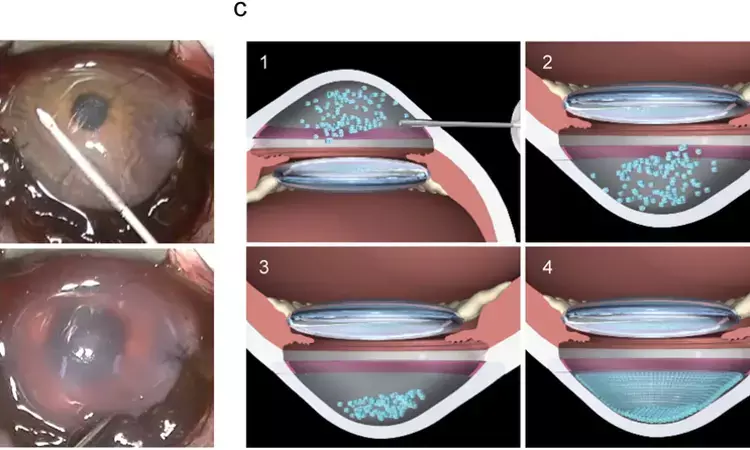- Home
- Medical news & Guidelines
- Anesthesiology
- Cardiology and CTVS
- Critical Care
- Dentistry
- Dermatology
- Diabetes and Endocrinology
- ENT
- Gastroenterology
- Medicine
- Nephrology
- Neurology
- Obstretics-Gynaecology
- Oncology
- Ophthalmology
- Orthopaedics
- Pediatrics-Neonatology
- Psychiatry
- Pulmonology
- Radiology
- Surgery
- Urology
- Laboratory Medicine
- Diet
- Nursing
- Paramedical
- Physiotherapy
- Health news
- Fact Check
- Bone Health Fact Check
- Brain Health Fact Check
- Cancer Related Fact Check
- Child Care Fact Check
- Dental and oral health fact check
- Diabetes and metabolic health fact check
- Diet and Nutrition Fact Check
- Eye and ENT Care Fact Check
- Fitness fact check
- Gut health fact check
- Heart health fact check
- Kidney health fact check
- Medical education fact check
- Men's health fact check
- Respiratory fact check
- Skin and hair care fact check
- Vaccine and Immunization fact check
- Women's health fact check
- AYUSH
- State News
- Andaman and Nicobar Islands
- Andhra Pradesh
- Arunachal Pradesh
- Assam
- Bihar
- Chandigarh
- Chattisgarh
- Dadra and Nagar Haveli
- Daman and Diu
- Delhi
- Goa
- Gujarat
- Haryana
- Himachal Pradesh
- Jammu & Kashmir
- Jharkhand
- Karnataka
- Kerala
- Ladakh
- Lakshadweep
- Madhya Pradesh
- Maharashtra
- Manipur
- Meghalaya
- Mizoram
- Nagaland
- Odisha
- Puducherry
- Punjab
- Rajasthan
- Sikkim
- Tamil Nadu
- Telangana
- Tripura
- Uttar Pradesh
- Uttrakhand
- West Bengal
- Medical Education
- Industry
Intracameral injection of Vigadexa not associated with higher degree of corneal endothelial cell loss

Intracameral injection of Vigadexa not associated with higher degree of corneal endothelial cell loss suggests a new study published in the Graefe's Archive for Clinical and Experimental Ophthalmology.
Intracameral antibiotics, such as moxifloxacin and cefuroxime, are safe to corneal endothelial cells and effective prophylaxis of endophthalmitis after cataract surgery. Corneal endothelial cells decrease in density after cataract surgery. Any substance used in the anterior chamber may affect corneal endothelial cells and lead to a greater decrease in density. This study wants to determine the percentage of endothelial cell loss after cataract extraction by phacoemulsification with off-label intracameral injection of moxifloxacin and dexamethasone (Vigadexa®).
An observational retrospective study was performed. The clinical records of patients undergoing cataract surgery by phacoemulsification plus intracameral injection of Vigadexa® were analyzed. Endothelial cell loss (ECL) was calculated using preoperative and postoperative endothelial cell density. The relation of endothelial cell loss with cataract grade using LOCS III classification, total surgery time, total ultrasound time, total longitudinal power time, total torsional amplitude time, total aspiration time, estimated fluid usage, and cumulative dissipated energy (CDE) was studied using univariate linear regression analysis and logistic regression analysis.
Results
The median loss of corneal endothelial cells was 4.6%, interquartile range 0 to 10.4%. Nuclear color and CDE were associated with increased ECL. ECL>10% was associated with age and total ultrasound time in seconds.
The endothelial cell loss after the intracameral use of Vigadexa® at the end of cataract surgery was similar to the reported in other studies of cataract surgery without the use of intracameral prophylaxis for postoperative endophthalmitis (POE). This study confirmed the association of CDE and nuclear opalescence grade with postoperative corneal endothelial cell loss.
Reference:
Galvis, V., Prada, A.M., Tello, A. et al. Safety of intracameral application of moxifloxacin and dexamethasone (Vigadexa®) after phacoemulsification surgery. Graefes Arch Clin Exp Ophthalmol 261, 3215–3221 (2023). https://doi.org/10.1007/s00417-023-06095-0
Keywords:
Intracameral, injection, Vigadexa, associated, higher, degree, corneal, endothelial, cell, loss,Galvis, V., Prada, A.M., Tello, Graefe's Archive for Clinical and Experimental Ophthalmology
Dr. Shravani Dali has completed her BDS from Pravara institute of medical sciences, loni. Following which she extensively worked in the healthcare sector for 2+ years. She has been actively involved in writing blogs in field of health and wellness. Currently she is pursuing her Masters of public health-health administration from Tata institute of social sciences. She can be contacted at editorial@medicaldialogues.in.
Dr Kamal Kant Kohli-MBBS, DTCD- a chest specialist with more than 30 years of practice and a flair for writing clinical articles, Dr Kamal Kant Kohli joined Medical Dialogues as a Chief Editor of Medical News. Besides writing articles, as an editor, he proofreads and verifies all the medical content published on Medical Dialogues including those coming from journals, studies,medical conferences,guidelines etc. Email: drkohli@medicaldialogues.in. Contact no. 011-43720751


